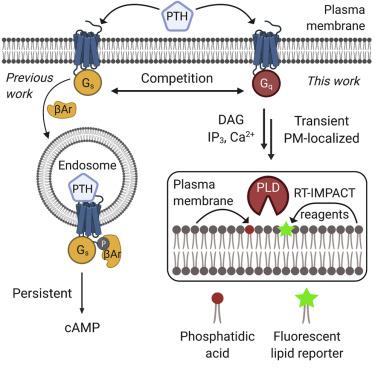Cell Chemical Biology ( IF 8.6 ) Pub Date : 2021-06-22 , DOI: 10.1016/j.chembiol.2021.05.020 Dongjun Liang 1 , Ross W Cheloha 2 , Tomoyuki Watanabe 3 , Thomas J Gardella 3 , Jeremy M Baskin 1

|
Canonically, G-protein-coupled receptor (GPCR) signaling is transient and confined to the plasma membrane (PM). Deviating from this paradigm, the parathyroid hormone receptor (PTHR1) stimulates sustained Gs signaling at endosomes. In addition to Gs, PTHR1 activates Gq signaling; yet, in contrast to the PTHR1-Gs pathway, the spatiotemporal dynamics of the Gq branch of PTHR1 signaling and its relationship to Gs signaling remain largely ill defined. Recognizing that a downstream consequence of Gq signaling is the activation of phospholipase D (PLD) enzymes, we leverage activity-based, bioorthogonal imaging tools for PLD signaling to visualize and quantify the Gq branch of PTHR1 signaling. We establish that PTHR1-Gq signaling is short lived, exclusively at the PM, and antagonized by PTHR1 endocytosis. Our data support a model wherein Gq and Gs compete for ligand-bound receptors at the PM and more broadly highlight the utility of bioorthogonal tools for imaging PLDs as probes to visualize GPCR-Gq signaling.
中文翻译:

磷脂酶 D 的基于活性的生物正交成像揭示了 GPCR-Gq 信号传导的时空动力学
典型地,G 蛋白偶联受体 (GPCR) 信号转导是短暂的并且局限于质膜 (PM)。与此范例不同的是,甲状旁腺激素受体 (PTHR1) 会刺激核内体持续的Gs信号传导。除了 G s之外,PTHR1 还激活 G q信号;然而,与 PTHR1-G s通路相比,PTHR1 信号转导的 G q分支的时空动力学及其与 G s信号转导的关系在很大程度上仍未明确定义。认识到 G q的下游后果信号是磷脂酶 D (PLD) 酶的激活,我们利用基于活性的生物正交成像工具进行 PLD 信号,以可视化和量化 PTHR1 信号的 G q分支。我们确定 PTHR1-G q信号是短暂的,仅在 PM 存在,并被 PTHR1 内吞作用所拮抗。我们的数据支持一个模型,其中 G q和 G s在 PM 竞争配体结合受体,并更广泛地强调生物正交工具用于成像 PLD 作为探针以可视化 GPCR-G q信号的效用。


























 京公网安备 11010802027423号
京公网安备 11010802027423号